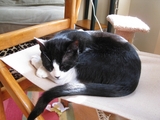When Vernon and Master Lin-chi joined my household I began to think seriously about cat nutrition. I looked at several websites and one book on the subject and began to inform myself.

The first thing you discover: a close reading of the nutritional analysis suffices to establish that commercial catfood is basically crap. Even the high end stuff is wanting.
Then there are the myths. Dry cat food? Worse than the moist. But isn’t it good for their teeth? No it isn’t. What about kitten, adult and “senior” cat food varieties? Total bullshit. 
Catfood manufacturers cynically exploit cat owners’ ignorance by extolling the wholesome goodness of their products containing cranberries and such. They must surely know that cats are obligate carnivores and have no use for cranberries, brown rice, seaweed, etc., no matter how wholesome-sounding. Shamefully, some veterinarians collude with these catfood manufacturers.
So what’s a cat owner to do? Well, what have cats done historically, before catfood was invented? Domestic cats lived by hunting and table scraps. Modern feral cats essentially do the same. My urban cats live strictly indoors; they get no birds and few if any mice in their diets. Table scraps won’t do it, as I eat little meat. My ziti with carmelized onions and broccoli rabe is of little use to them. It’s up to me to simulate something close to their natural diet by providing them with fresh meat and organs purchased for that purpose.
I read about people buying meat grinders and grinding up turkey, chicken and rabbit and feeding it to their cats. This sounded like a cool idea so I got myself a grinder, and promptly broke it on a turkey bone. While procrastinating about calling the manufacturer and inquiring about a repair, I tried paying top-dollar for something called Carnivore Diet, five-pound tubes of ground beef and bone. This seemed like the real deal, and the cats loved it, although there is something unnatural about domestic cats feeding off an animal so many times their size. And at over $15 for the five pounds, it was expensive.
While continuing to procrastinate about the grinder repair, I came across other websites that said grinding is nonsense. When you increase all that surface, you facilitate the growth of taurine-eating bacteria. Do they eat ground mice and birds in the wild? No. The non-grinding school advocates taking things like raw chicken and chopping it into manageable pieces, bones included, and giving to your cats. Ah ha! This approach has the irresistible appeal of Ockham’s Razor. Who would have thought that the best way to feed your cat also happens to be the simplest? Get out your meat cleaver and a solid cutting board. Get a chicken or some turkey parts. Hack into pieces. Serve. For dietary balance give them some beef hearts, chicken livers, etc.
Considering cost, this solution compares favorably to the high-end commerical cat food. Perhaps it’s more expensive — if so, it’s worth it. People are fond of comparing pets to members of the family. Would you feed garbage to your human loved ones? Would you begrudge the expense of their nourishment? And to be strictly pragmatic about it, the savings on vet bills over your cat’s longer, healthier life helps offset the expense. (Of course, you could counter-argue that the cat’s extended life means more food consumption, ergo expense. But you’d probably get another cat who would also eat, so it’s a wash. Perhaps it boils down to how long you live. Cut your living expenses: smoke cigarettes.)
A further benefit of the raw flesh diet is that it’s satisfying for the owner. Nothing is more pleasing than the sound of their little jaws cracking bone, their growling as they warn each other away from their chunk of heart. This is real food. On the rare occasion when I run out of flesh and open a can, I am apalled at its contents: a gray and foul-smelling industrial sludge.
Case 37: The Oak Tree in the Garden

“Either you real or you ain’t”
The other day one of the teachers in our zendo gave a talk in which she likened the practice of zen to classical ballet: one of the most painfully demanding of disciplines. Dancers must show up for a 90 minute class every single day without fail, no matter how experienced and accomplished they are or think they are. Always showing up, always striving, tuning, preparing for the stage — that’s what it’s about. So it is with the Zen practitioner. You show up at the zendo for formal zazen as often as you possibly can, regardless of whether you feel like it or whether it’s convenient. Formal zazen is essential, a necessity. LIkewise, extended sittings such a as zazenkai and sesshin are not optional add-ons. They are what you do when you’re a Zen practitioner.
This idea was reinforced by a scene that I recently saw in an episode from the fifth season of the venerable HBO series The Wire. During a prison visit, the incarcerated father admonishes his son to apply himself with greater diligence to his work in the drug trade. Either you real or you ain’t, he says. Irony notwithstanding, this paternal advice underscores a valid point. The teacher’s talk was evidently aimed at students who she thought needed to hear it. She might as well have said, either you real or you ain’t.
I was reminded of something my family has said about me over the years: you are a fanatic, an addictive personality. When you set your mind to something, you go at it relentlessly, obsessively. I have always tended to think, well, ok. When they suggested that going away for a week-long sesshin last summer was an example of my fanaticism, I figured, whatever. Now I am not so sure. Sesshin is what zen practitioners do. Why do this at all unless you’re serious? Either you real or you ain’t.
Update
Looking at the above three months later, I see the fallacy in the argument “I am not a fanatic; sesshin is what Zen practitioners do.” Sitting in meditation several hours a day for a week is extreme — fanatical, even. Dedicated Zen practitioners are fanatics.
MLK’s Mountaintop Speech
There was a good piece on NPR this morning about Martin Luther King’s last speech, in which he said he was not concerned about longevity because he had been to the mountaintop and looked over. Just the night before I had been pondering the koan from which the phrase “All is vast and boundless” is taken. While listening to King’s speaking voice coming out of the radio in my kitchen 40 years after the fact, it occurred to me that King himself must have realized that all is vast and boundless. It doesn’t matter what you call it.
The Cat in the Hat: best book ever
I sometimes think the best book of all time is the Cat in the Hat. No, not the best children’s book. Just the best book, period. You know the part where the Cat is juggling all that stuff. Then more stuff. Then even more. Then it all comes crashing down spectacularly. I love that. Then there’s Thing One and Thing Two. You can’t beat the Things. They’re the coolest.
On being burgled
I came home the other day to find that one of the two windows in my bedroom had been shattered. My apartment is on a third floor; the fire escape is accessible through these windows, and vice-versa. At first I thought, that’s odd. A window broken, yet everything seems otherwise intact. The previous day had been a holiday for us public sector workers and I had devoted nearly all of it to cleaning and straightening out this apartment, so it was exceptionally neat and organized. Computer equipment and sexy skinny TV, still in place. Beautiful flowers on the clutter-free dining room table.
Later that evening as my four-year-old daughter and I were sitting down to dinner I had the impulse to take a picture. Oops, no digital camera. Hmmm, how about that portable computer that my mom gave me? Also gone. I had been considering whether to report the incident to the police — what can they do? Is there any point? — but at this point I decided I would definitely do so, if only to become an official statistic. Let the record reflect that this guy’s apartment was broken into one day in February 2008 and his laptop and camera were stolen.
Two Jersey City police officers came promptly, and were impeccably courteous and professional. They summoned two more cops to the scene to look around and ask questions, then they left.
My bedroom was impossibly cold, and my daughter’s is closer to the gaping window than the living room is, so I decided my daughter and I would both sleep on the fold-out in the living room that night. I felt curiously equanimous in the face of an experience that most reasonable people find distressing — “violated” is the word people use to describe the feeling resulting from such intrusions. It was disturbing and inconvenient, but my material losses were modest and I felt I had gotten off easy. We went to sleep.
Ah, but at 3:30 a.m. I woke up a bit paranoid about the window open to the world, and did not get back to sleep. At around 5:00 I decided to get up and do zazen. The blinds rattling in the wind sounded like a person sneaking in, and scared the shit out of me before I figured out it was just the wind. As my mind meandered along, it ocurred to me that next time I come home and put my key in the lock, I will not know what to expect. In the next instant I thought, yes, but you never know what to expect when you put your key in the door. Indeed you don’t even know if there will be a door. Welcome to reality. Back to the breath.
I have no ill will against the intruder. I do not want the incident to recur, but that’s entirely different. In the days since the break-in I have wondered about the experience from the burglar’s point of view. Who is she or he? A drug addict? How old? What race or ethnicity? The intruder evidently exited through the window adjacent to the one through which she entered, because I found it unlatched, and why risk cutting yourself on broken glass? She thoughtfully lowered it behind her, perhaps to keep the cats from escaping. I imagined Vernon and Lin-chi, ever sociable, greeting her warmly as she made her way through the kitchen and into the living room searching for portable items of value. Will you feed us, they must have asked.
You know how it is when you enter someone’s home for the first time as a guest. You look around and take in the whole environment. Then, if left to your own devices for a couple minutes, you amble over to the bookcase and inspect the titles. You look at the art on the walls, perhaps the music collection. Looking, looking with pure, normal curiosity for things of interest, points of contact between guest and host.
What did my apartment look like through the thief’s eyes? What did she observe? What registered? Anything? Did she notice the photographs on the refrigerator? The zabuton and seiza bench? The childrens’ drawings taped up everywhere? Did the intruder form any impression at all of the apartment and its inhabitants?
We will never know, but it makes for interesting speculation.
Ah, the Department of State
You spend numerous minutes filling out a multi-page “wizard” for your passport renewal application. You notice that when you click a checkbox somewhere, the whole page pointlessly reloads with the data in the same state. It’s annoying, but you carry on.
You notice that when your textfield input exceeds the maximum number of characters allowed, instead of just refusing to accept more characters, this form has some Javascript that erases all your input in that field, so you have to start over. Very annoying, but you carry on.
You notice an error in your input, but when you put your mouse cursor in the field to edit it, all the input disappears, so you have to start over.
By now you’d like to have a talk with the people who coded this application — even more so, with the people who tested it and declared it production-ready. But you sigh and carry on until the final page, and then…
Index was outside the bounds of the array.
Description: An unhandled exception occurred during the execution of the current web request. Please review the stack trace for more information about the error and where it originated in the code.
Exception Details: System.IndexOutOfRangeException: Index was outside the bounds of the array.
Source Error:
An unhandled exception was generated during the execution of the current web request. Information regarding the origin and location of the exception can be identified using the exception stack trace below.
Stack Trace:
[IndexOutOfRangeException: Index was outside the bounds of the array.]
WizardManagerForNewForms.processControls(Control control, String FormType) +31109
WizardManagerForNewForms.processControls(Control control, String FormType) +31063
WizardManagerForNewForms.processControls(Control control, String FormType) +31063
WizardManagerForNewForms.UpdateApplicantData(StateBag activeViewState, ControlCollection activeControls, String ApplicantSSN, String ApplicantFirstName, String FormType) +313
[etc]
Version Information: Microsoft .NET Framework Version:2.0.50727.832; ASP.NET Version:2.0.50727.832
Lovely, isn’t it? For you non-geeks out there, this type of verbose technical information is often useful to the developers of a program in the course of debugging — although usually only a couple lines of the strack trace are actually relevant to your problem (the function that dumps the stack trace doesn’t know that, so it gives you the whole thing). But you the end user do not know or understand any of this, nor should you. What you should see, if the application pukes, is a polite and vague error message apologizing for the inconvenience, while behind the scenes the technical stuff is saved in a log file or other storage. The geek-speak is just annoying and confusing mumbo-jumbo.
Displaying all the error output is not just bad form. It also leaks internal information that might be useful to a potential attacker. It should be none of our business that State is running
Microsoft .NET Framework Version:2.0.50727.832 and ASP.NET Version:2.0.50727.832 and that it bombs when it tries access an array element that does not exist.
Whether it’s a .NET issue, or an application-level bug, I gotta go. I have a paper passport renewal application to fill out.
Two true stories
Rising from the mat
I go into the kitchen
to prepare some tea.
The avocado
you left here the other day
is perfectly ripe.
poetry in the bathroom
taken away from my
customary diet
I become
stopped up.
struggling to squeeze out
two or three small turds
there is more than
time enough
to examine the poetry
books piled high in
Ann’s bathroom
Reading Cormac McCarthy
I had to see the Coen brothers’ realization of Cormac McCarthy’s novel No Country for Old Men because I knew it had to be superb. It was. I hadn’t read the book, so I had to read it after rather than before seeing the film. The book was magnificent, and made me want to grab another one that I hadn’t read, The Road. That’s when I ran into a little trouble.
For a learned assessment of The Road, go see this NYRB review. All I have to say is that I am about 200 pages in and I find it exceptionally disturbing and distressing. None of the cliché adjectives like “searing” come close. It is as dreadful, horrible, bleak, dark and depressing as it is beautifully written. Perhaps what makes it hard to bear is the singularly anguishing nightmare scenario in which a parent struggles moment to moment to keep his child from starvation, freezing, or worse — struggles to no end, for there is no future. If you are not in robust mental health I would say stay away. I think mine is pretty solid and yet this book makes me wonder.
Why? What’s the big deal, it’s only a book, right? Yes, a work from the imagination of one person. But the horror and suffering it points to is all too real. It exists. We usually avoid facing that fact in order to survive. The Road forces you to confront that horror straight on, no flinching or averting your gaze.